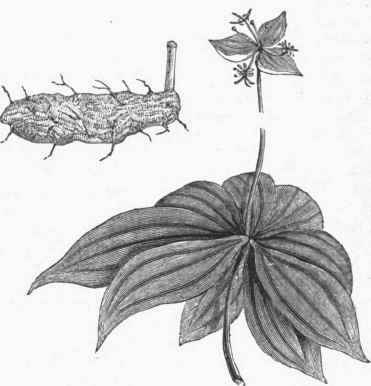Indian Cucumber
Description
This section is from "The American Cyclopaedia", by George Ripley And Charles A. Dana. Also available from Amazon: The New American Cyclopędia. 16 volumes complete..
Indian Cucumber
Indian Cucumber (a name given to Medeola Virginica, a common and striking plant of the lily family, which is found in May and June in rich damp woods from Canada to Florida. The remarkably white tuberous root stock is about 2 in. long and 1/2 in. thick, and has the taste of cucumber; it is said to have been eaten by the Indians, whence the common name. The simple slender stem, 1 to 3 ft. high, is partly clothed with a whitish wool which readily separates; near the middle it bears a whorl of five to nine obovate, lanceolate, pointed thin leaves; at the summit are the flowers, immediately below which is another whorl of, usually, three smaller leaves. The flowers (three to six) have three petals and three sepals, all of the same greenish yellow color, and recurved; stamens six, pistil one with three long threadlike brownish styles diverging from the top of the globose ovary, which in ripening forms a dark purple berry of the size of a pea. The botanical name is the diminutive of Medea, the sorceress, probably given to the plant on account of reputed medicinal powers; it really possesses very little activity, though the elder Barton thought it serviceable in dropsy.

Indian Cucumber (Medeola Virginica).
Continue to:


